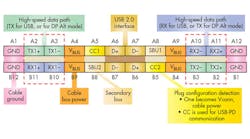This file type includes high resolution graphics and schematics when applicable.
When USB 1.0 was released in 1996, it delivered 1.5 Mbps. Through the years, it has increased transfer rates up to 10 Gbps. The latest USB 3.1 can support a wide range of USB peripherals. The new Type-C will support multiple standards (e.g., USB 2.0, 3.0, 3.1, Thunderbolt, Display Port, and MHL) and it will bring consolidation to a market tangled with so many different cables. Consumers will be able to eventually buy one cable that will serve as a universal connector (Fig. 1).
The USB-IF describes the USB type-C connector as:
- A slim and sleek connector tailored to fit mobile-device product designs, yet robust enough for laptops and tablets.
- Supporting scalable power and performance to future-proof your solution.
- Featuring reversible plug orientation and cable direction.
In 2012, USB-IF created a specification called USB Power Delivery. Power Delivery protocols have been updated to facilitate USB Type-C to provide power delivery along with data over a single cable. USB Power Delivery offers multiple features such as:
- Increased power levels from existing USB standards up to 100 W.
- Power direction that is no longer fixed. Bi-directional power allows a device to send a receive power, enabling a peripheral device to also now charge a host.
- Optimized power management across multiple peripherals: Power can be transferred while the device is transmitting data across the connection. It allows devices to take only the power they require.
USB Type-C Design Challenges
With increased simplicity for end users comes increased complexity from a design and engineering perspective. There are substantial design and test challenges that designers will face by creating a USB Type-C connector that enables backwards compatibility and reversible use with all of the features mentioned.
Keysight Technologies’ Marketing Manager Brig Asay pointed out some of the design challenges that this new technology will create. (Fig. 2). For starters, the PHY layer presents a challenge because now the connector is reversible and supporting higher rates and power. A Cable Detect (CD) function is implemented and CC1 and CC2 help determine if they are connected to the Downstream Facing Port (DFP) or Upstream Facing Port (UFP) as well as the orientation of the cable. There are now two high-speed data paths to handle data rates up to 10 Gbits/s.
Implementing USB type-C and USB 3.1 also creates a signal challenge, due to the signal complexity required across the 24-pin connector. Channel response is affected by loss, reflection, cross-talk, and mode conversions. Consequently, signals are severely degraded in the channel and many tests need to be implemented. They include BERT error detection and performing high-speed interconnect analysis including impedance, S-parameters, etc. At the same time, EMI and RFI levels from the cable assembly need to be controlled.
USB Type-C and USB 3.1 are backward-compatible with USB 3.0 and USB 2.0. Adapters will allow you to plug your legacy devices into a Type-C port. Because USB Type-C is a new technology, be aware that there are non-compliant Type-C new adapters and cables in the market that are using a 10-kΩ resistor instead of the 56 kΩ that should be standard for Type-C cables. In other words, a connected device may attempt to draw 3 A, when the power source (the USB port on your computer, a third-party wall charger, etc.) is only rated to supply 2A, potentially damaging your power source.
It will take some time for USB Type-C to become as popular as the current USB Type-A. But with the expanding presence of smartphones and wearables in our modern lives, this new standard will be globally welcomed and adapted by all type of industries. In the near future, consumers will finally have one cable for any device, for data, and for video and power connections.
This file type includes high resolution graphics and schematics when applicable.



